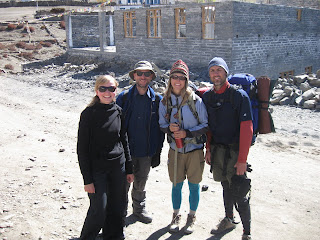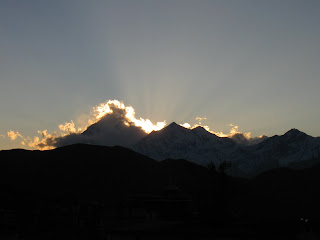Bon predates Buddhism by hundreds or even thousands of years. The Buddha was born in Nepal about 500 years before Christ was born. I wanted to see a working place of worship for a religion which predated Christianity by centuries.
That's right, it's yet another thing that may interest only me!
I started south from Kagbeni. Immediately I got stuck in the morning rush hour.
 I continued through the small village of Eklhaibhatti, crazily located in the Kali Gandaki river bed.
I continued through the small village of Eklhaibhatti, crazily located in the Kali Gandaki river bed. There are a couple stone walls to divert high water, but this place strikes me as a minor disaster waiting to happen.
There are a couple stone walls to divert high water, but this place strikes me as a minor disaster waiting to happen.I posted a picture of the YacDonald's in Kagbeni in a previous post. I thought it fitting that a restaurant which blatantly rips off an American corporate icon is also the only one I saw that advertised on the trail.
 Then I made a left up the narrow Panda Valley. The walk was miserable. There wasn't a trail. It was a river bed literally covered with smooth rocks, most the size of bowling balls. It only took about an hour to get from the main trail to the village but it was tiring and hard on my ankles.
Then I made a left up the narrow Panda Valley. The walk was miserable. There wasn't a trail. It was a river bed literally covered with smooth rocks, most the size of bowling balls. It only took about an hour to get from the main trail to the village but it was tiring and hard on my ankles.The sun was rising just behind the village which made getting a photo next to impossible for a pointer-and-clicker like me. This shot gives an idea of the treacherous walking conditions, as well as how tiny the village is.

This tiny enclave of 16 homes has managed to keep alive a religion that has disappeared or been absorbed by Buddhism virtually everywhere else.
I had seen signs of the religion in Kagbeni. There were fetishes above doorways.

Just outside the gompa in Kagbeni is a carved human figurine embedded in a wall.

As I noted in a previous post the swastika, long before it became known in the western world as a symbol of Nazism, was a Buddhist and Hindu symbol. It was also a Bon symbol. With a slight twist. Literally.
I saw this on the prayer wall at the gompa in Kagbeni.

The swastika at the bottom "turns" to the right as it does in Buddhism (and Nazism). The one at the top, however, turns to the left, as in Bon. It was the only Bon swastika I saw there. I asked a young monk why this one particular swastika was different from the rest. He didn't know about it! It really is something that interests only me!
The stupa at the entrance to Lupra is unlike any I've seen in Nepal, or anywhere else for that matter.
 I could tell by the way people stopped and stared the village doesn't get a lot of tourists. I asked where the gompa was. Of course it was at the top of the hill.
I could tell by the way people stopped and stared the village doesn't get a lot of tourists. I asked where the gompa was. Of course it was at the top of the hill. When I got there it was closed. Word had gotten around so soon a woman came to unlock it for me.
When I got there it was closed. Word had gotten around so soon a woman came to unlock it for me.I wasn't allowed to take pictures, which wasn't a big deal, as it turned out. I have to admit I was disappointed. To my admittedly untrained Western eyes the Bon temple, called Yungdrung Phuntshakling, was virtually indistinguishable from a Buddhist temple. It's not surprising, considering Buddhism more or less absorbed Bon. The two religions have co-existed for thousands of years. My side trip sounded a lot more interesting on paper than it actually was.
I headed back down the boulder-strewn valley and headed towards Jomsom, the main hub of the western leg of the Annapurna Circuit. I was hiking down the Kali Gandaki river valley. I saw children playing and families picnicking in the riverbed. I have no idea why or where they came from.
 Jomsom sits in the distance, with Dhaulagiri, the seventh-highest mountain in the world, looming overhead. Off camera to the left is Annapurna, the 10th-highest. Because the river runs between these two peaks this valley is considered to be the deepest in the world.
Jomsom sits in the distance, with Dhaulagiri, the seventh-highest mountain in the world, looming overhead. Off camera to the left is Annapurna, the 10th-highest. Because the river runs between these two peaks this valley is considered to be the deepest in the world.As I walked I was debating what to do. I wasn't sure I wanted to continue hiking on the trail. On this side of the circuit the trail is an actual road. I was constantly having to step out of the way of vans, jeeps and motorcycles. It really sucked the romance out of an otherwise perfect day for hiking.
I saw very few hikers. Most people were in a vehicle or on mountain bikes or, like these folks, on horseback.

I was feeling strong and fresh for the first time in days. Why not keep walking?
Then again, I could also avoid a lot of the road traffic by taking a bus from Jomsom to Tatopani and then continuing on foot. Maybe I could visit Annapurna Base Camp again? Or maybe not. The trail out of Tatopani ascends a sadistic 1,900 meters, the longest climb on the Annapurna Circuit. That's nearly a mile and a quarter of vertical distance, not walking distance.
I was hiking on the flattest, widest section of trail I had ever seen in Nepal, which made what happened next all the more bizarre. One second was cruising along. Then I was lying face down in the dirt with a badly sprained ankle.
I have no idea what happened. I completely wiped out. My guess is that all the boulder hopping in the morning had weakened my ankles. Whatever the reason, I could barely put any weight on my left foot.
Here is a picture of my ankle.

I sprained it on October 30. This picture was taken on December 27. It's still swollen two months later. Luckily I had my trusty hiking pole to lean on. Even more luckily my next stop was a village with an airport.
All things considered I was incredibly fortunate the mishap occurred where it did, which was right about here.
 I didn't have far to walk. I hobbled into Jomsom, found the first available hotel room, booked a flight out for the next morning, and took a few obligatory photos before hopping into bed to rest my ankle.
I didn't have far to walk. I hobbled into Jomsom, found the first available hotel room, booked a flight out for the next morning, and took a few obligatory photos before hopping into bed to rest my ankle.Jomsom is a soulless place. I didn't mind that it's "modern". It just has no personality.

It does have, however, perhaps the best setting for an airport in the world.

I hope the guy who painted this advertisement for rock climbing was paid well.

If I had been in a village I liked, such as Manang or Kagbeni, I might have rested for a few days and continued hiking. I had no desire to stay in Jomsom.
I was glad I decided to leave when I checked out in the morning. I had spent two weeks sleeping in lodges owned by the most gracious and welcoming people. The owner of my hotel in Jomsom tried to overcharge me for my room, even though the prices are printed in the menu.
I had seen everything I wanted to see on the trail. I had been trying to convince myself to hike the entire circuit, just to say I had done it, but I wasn't at all enthusiastic about dodging traffic for the next few days. I had already been to Annapurna Base Camp. I don't feel like I missed out on anything. I was as content as I could be with a sprained ankle.
I had seen everything I wanted to see on the trail. I had been trying to convince myself to hike the entire circuit, just to say I had done it, but I wasn't at all enthusiastic about dodging traffic for the next few days. I had already been to Annapurna Base Camp. I don't feel like I missed out on anything. I was as content as I could be with a sprained ankle.

















































